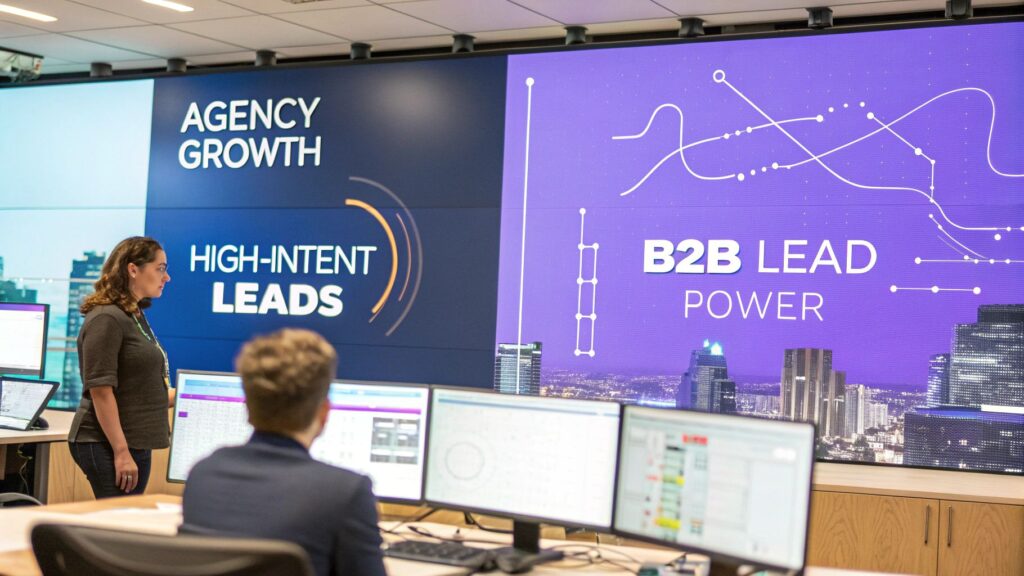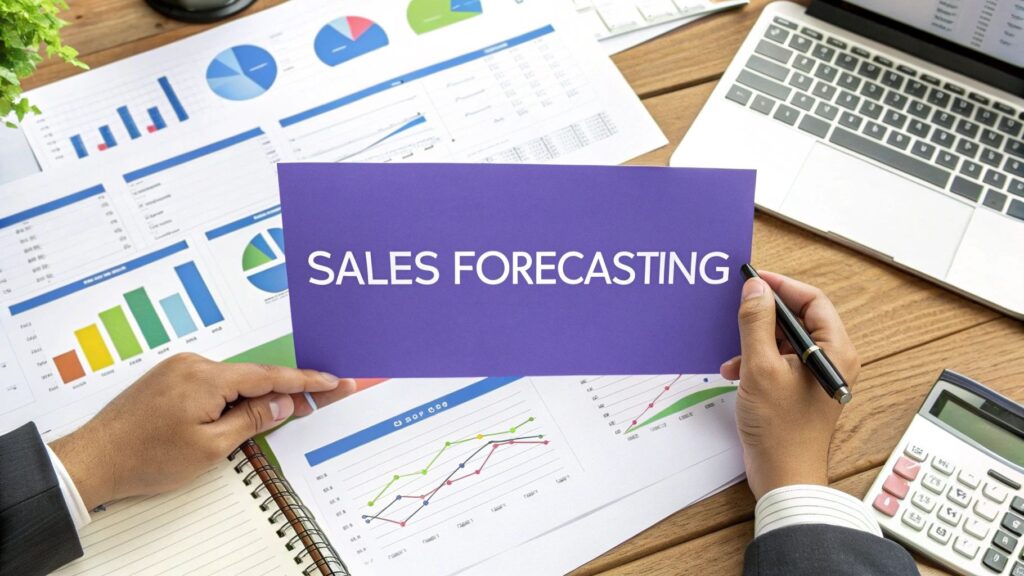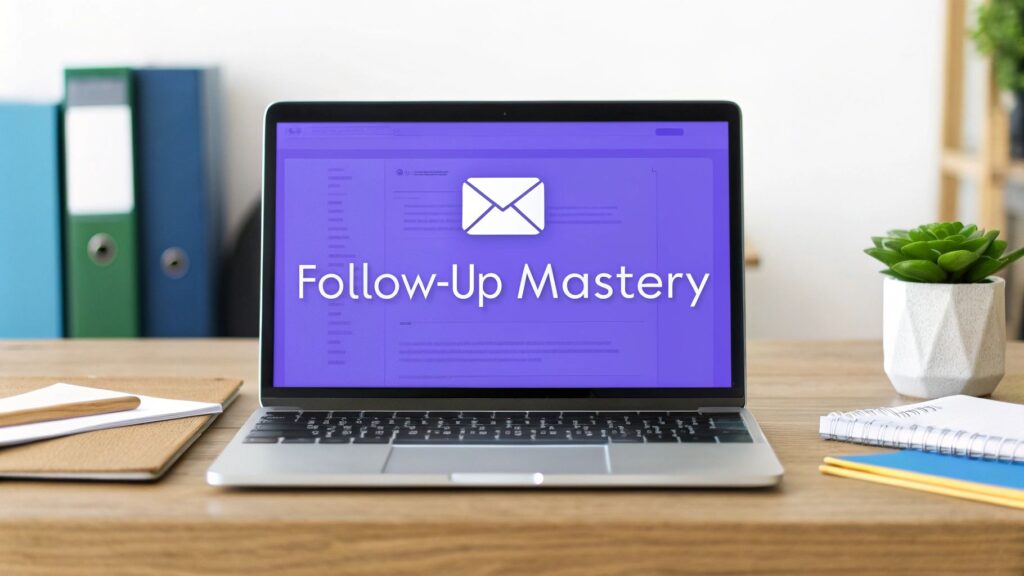What Is Series B Financing? The Ultimate Guide
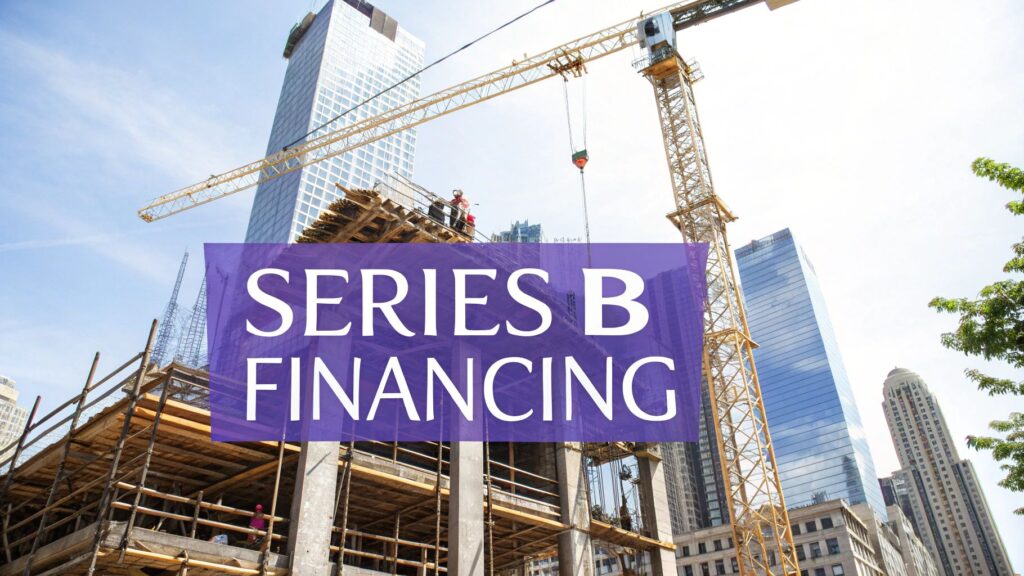
- Decoding Series B: The Growth and Expansion Stage
- The Players and Stakes of a Series B Round
- The Numbers That Get You to Series B
- How to Navigate the Series B Fundraising Process
- Current Trends Shaping Series B Investments
- Life After Funding: Putting That Capital to Work
- Got Questions About Series B? We've Got Answers.
So, you’ve survived the early days. Your startup has found its footing with a solid product, and you’ve even secured that crucial Series A round. What comes next? For many growing companies, the answer is Series B financing.
This round is all about one thing: growth. It's the fuel you need to go from a promising startup to a genuine market contender. While earlier funding stages are about finding product-market fit and building a foundation, Series B is where you hit the accelerator.
Decoding Series B: The Growth and Expansion Stage
Think of your startup’s funding journey like building a house. The Seed round is the blueprint and laying the foundation. Series A is framing the house and getting the basic structure in place. Series B is when you build out all the rooms, add a second story, and start landscaping the yard. You’re not just building to exist anymore; you’re building to dominate the neighborhood.
At this point, you've proven your business model works on a smaller scale. You have a steady stream of revenue, a loyal user base, and a clear idea of how to acquire new customers. The big question is no longer "Will people buy this?" but rather, "How fast can we grow and capture the market?"
To give this some context, let's quickly compare where Series B fits into the typical startup funding lifecycle.
Startup Funding Stages at a Glance
| Funding Stage | Primary Goal | Company Maturity | Typical Raise Amount |
|---|---|---|---|
| Seed | Validate the core idea and build a Minimum Viable Product (MVP). | Early-stage, pre-revenue, or with initial traction. | $500k – $3M |
| Series A | Achieve product-market fit and develop a repeatable sales model. | Established user base and consistent revenue. | $3M – $15M |
| Series B | Aggressively scale operations and expand market share. | Proven business model with strong growth metrics. | $15M – $50M+ |
This table shows the natural progression. By the time you reach Series B, you're playing in a different league, with much higher stakes and expectations.
What Series B Capital Really Achieves
The money raised in a Series B round isn't for experimenting or finding your way. It’s a calculated investment poured into very specific, high-growth activities. Founders typically use these funds to:
- Scale the Team: This is a huge one. You’re not just hiring more developers or a few salespeople. You’re bringing in experienced VPs, building out entire departments, and recruiting top-tier talent that can manage growth at a massive scale. For example, a fintech company might hire a VP of Engineering with experience scaling systems to 10 million users.
- Market Expansion: Time to go bigger. This could mean launching in new countries, targeting entirely new customer segments, or doubling down on the markets where you're already winning. A B2B SaaS company might use funds to open its first European office in London or Dublin.
- Product Development: While the core product is solid, Series B funds are often used to build a more robust product suite. The goal is to create a competitive "moat"—features and services that make it incredibly difficult for competitors to catch up. A project management tool might add enterprise-grade security features or AI-powered analytics.
This "scale-up" mentality is what separates Series B from everything that came before. You’re building on what you’ve already proven works.
As the visual suggests, Series B is about constructing a much larger, more dominant enterprise on the solid foundation you already laid.
The Shift in Investor Mindset
The investors you talk to for a Series B round are a different breed. Early-stage investors bet on a great team and a visionary idea. Series B investors, on the other hand, are all about the data. They’re less interested in your founding story and far more interested in your metrics.
A company seeking Series B funding must demonstrate not just that its product works, but that its business model works at scale. The conversation moves from "Can you build it?" to "Can you sell it efficiently to a massive audience?"
Your pitch deck can't just be a compelling narrative anymore. It needs to be backed by hard numbers—customer acquisition cost (CAC), lifetime value (LTV), churn rates, and month-over-month revenue growth. Investors need to see a clear, predictable path to market leadership and a healthy return on their capital. The dream is still important, but now it needs a spreadsheet to prove it.
The Players and Stakes of a Series B Round
Once you hit the Series B stage, the entire game changes. You’re no longer dealing with the angel investors or early-stage funds who took a chance on your vision back in the Seed or Series A days. The conversation gets a lot more serious, and the people on the other side of the table are a different breed altogether.
We're talking about established Venture Capital (VC) firms that specialize in pouring fuel on a fire that’s already burning bright. They aren't just writing a check based on a cool idea; they're making a calculated bet that your company has the chops to become a true market leader. They bring the capital, sure, but they also bring deep industry connections and often a board member who will hold you accountable for disciplined, aggressive growth. The stakes, for everyone, just got a lot higher.
Who Writes the Checks and What They Expect
Series B investors are typically the big players—well-known VC firms with serious capital to deploy. You'll often see names like Index Ventures or Andreessen Horowitz (a16z) leading these rounds. Their investment decisions are driven by hard data and proven traction, not just a charismatic pitch deck.
They’re looking for stone-cold proof that your business is a well-oiled machine, ready to scale. Specifically, they'll be digging into:
- Predictable Revenue: Can you show them a clear, repeatable process for winning customers and generating revenue? They want to see a formula, not a fluke. For SaaS companies, this means a consistent sales pipeline and low customer churn.
- Market Dominance Potential: It's not enough to be in a good market. They want to see your roadmap for capturing a huge slice of it. This might involve a competitive analysis showing how you'll unseat incumbents.
- Operational Scalability: You need to convince them your team, tech, and processes won't fall apart when you triple your customer base overnight. This means showing you have robust infrastructure and a plan for hiring key leadership roles.
In short, they assume you've already found product-market fit. Now, they're underwriting your plan for rapid, aggressive expansion. The conversation shifts from "the dream" to "the data-driven execution plan."
Understanding Deal Sizes and Valuations
The numbers in a Series B can feel massive, with rounds typically falling between $15 million and $50 million. But be careful with averages—they can be incredibly misleading. For example, in the first four months of 2025, a few monster deals pushed the average raise to an eye-watering $182.4 million, while the median was a much more realistic $38 million.
This gap tells an important story. While the headlines are full of "mega-rounds," most successful Series B fundraises are built on solid valuations backed by even more solid performance.
Your company's valuation at this point is a direct reflection of your traction. VCs will put your Annual Recurring Revenue (ARR), growth rate, and gross margins under a microscope to land on a number. Valuations can certainly push past $100 million, but every dollar of that figure is tied to your ability to prove you can deliver a massive return. For a deeper dive into how VCs arrive at these numbers, it’s worth exploring real-world startup equity data. This round is where you cement your company's position and set the stage to become a real force in your industry.
The Numbers That Get You to Series B
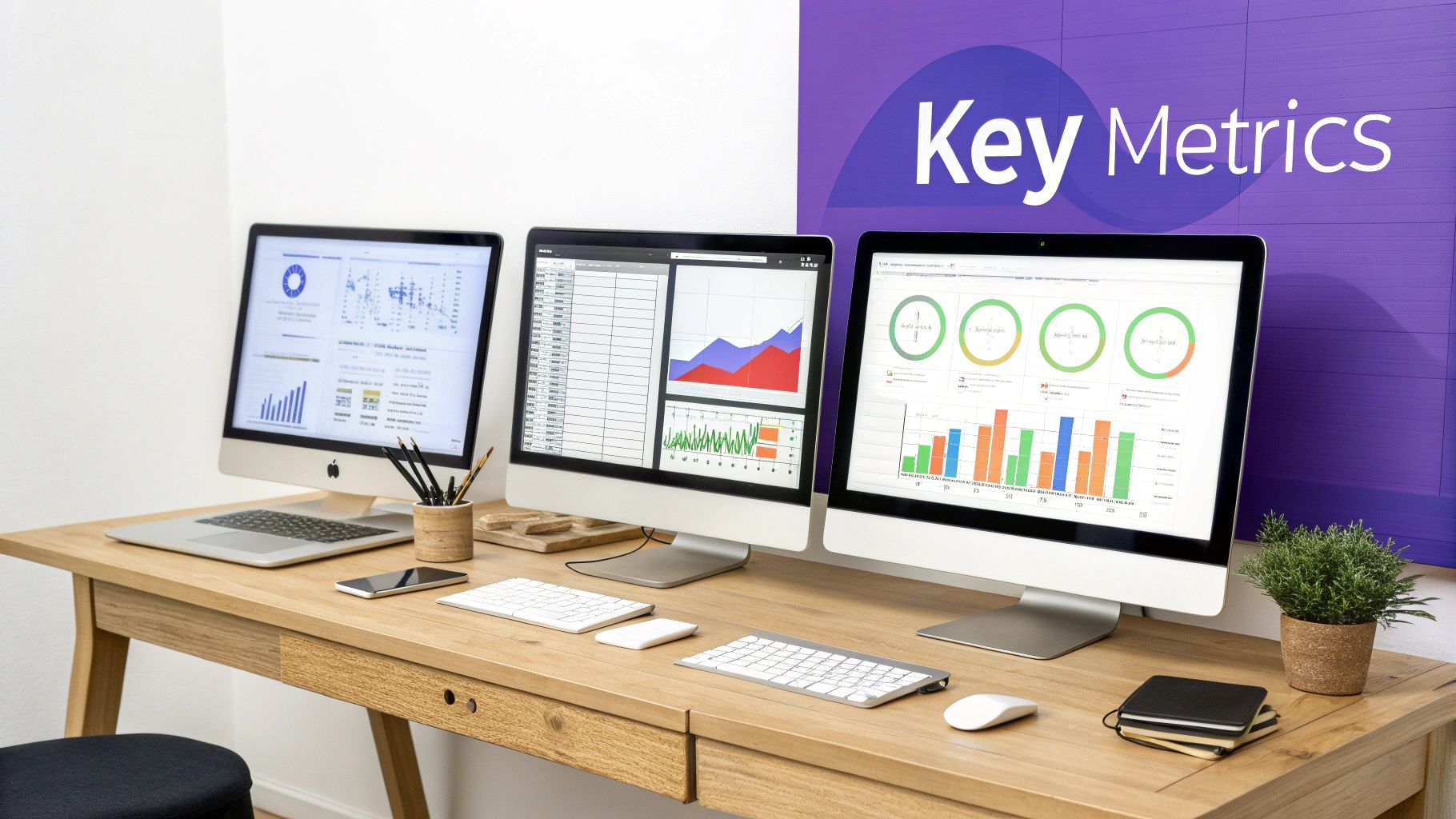
If your Series A round was won with a great story and a promising product, your Series B will be won with cold, hard data. At this stage, investors aren't just betting on a vision; they're investing in a proven, scalable business engine. They’ve seen countless big ideas. Now, they need to see a company that knows how to grow efficiently.
This is where your key performance indicators (KPIs) move from the background to the main event. Forget vanity metrics like social media followers or total downloads. We're talking about the core financial metrics that paint a clear picture of your company's health and its potential to generate serious returns.
More Than Just Revenue: Proving Your Growth Engine Works
To even get a foot in the door for a Series B conversation, you need a firm grasp on the handful of metrics that signal a healthy, predictable business. Investors will dig deep into these numbers to see if you’ve built something that can truly scale.
Here are the big ones they’ll be looking at:
- Annual Recurring Revenue (ARR): For any subscription-based business, this is your north star. Investors typically look for an ARR between $1 million and $5 million as a starting point, proving you have a stable and growing income stream.
- Customer Acquisition Cost (CAC): How much does it cost you to land a new paying customer? A low, stable CAC shows you have an efficient marketing and sales machine, not just a money pit.
- Customer Lifetime Value (LTV): This is the total revenue you can expect from a single customer over their entire time with you. A high LTV means your product is sticky, customers are loyal, and your business is built for the long haul.
Look at how Omni handled their announcement. When they raised a $69 million Series B, they didn't just talk about their product; they highlighted their 8x year-over-year growth in both revenue and customer usage. That’s the kind of measurable traction that makes VCs pay attention.
The Magic Ratio: Proving Your Business Model is Sustainable
While each metric is important on its own, the real magic happens when you show how they relate to each other. The relationship between your numbers tells the story of your company's efficiency and long-term viability.
The most crucial calculation here is the LTV to CAC ratio. It's the ultimate measure of your business model's health. A strong ratio is generally considered to be 3:1 or higher—meaning for every dollar you spend to get a customer, you make at least three dollars back.
Another metric that gets investors excited is net revenue retention. This shows how much your revenue from existing customers grows over time, factoring in upgrades and churn. A rate above 100% is the gold standard. It proves that your existing customers are so happy that they’re spending more with you over time, creating a powerful, self-fueling growth loop. For example, a company with 110% NRR is growing by 10% from its existing customer base alone, without signing a single new client.
Nailing these metrics demonstrates that your company isn’t just growing; it’s growing smart.
To help you prepare, here's a look at the essential KPIs that will be the centerpiece of your Series B pitch deck. Think of this as your pre-flight checklist before you start meeting with investors.
Essential Metrics for Your Series B Pitch Deck
A breakdown of the key performance indicators (KPIs) Series B investors scrutinize, along with target benchmarks that signal a healthy, scalable business.
| Metric | What It Measures | Typical Investor Expectation |
|---|---|---|
| Annual Recurring Revenue (ARR) | Predictable revenue from subscriptions over a year. | $1M – $5M to start the conversation. Growth should be at least 2-3x year-over-year. |
| Customer Acquisition Cost (CAC) | The average cost to acquire one new customer (sales & marketing spend / new customers). | Should be low enough to be paid back within 12 months. |
| Customer Lifetime Value (LTV) | The total net profit a company makes from any given customer. | Needs to be significantly higher than your CAC. |
| LTV to CAC Ratio | The ROI on customer acquisition efforts. The ultimate health check. | 3:1 or higher is the standard for a sustainable SaaS model. |
| Net Revenue Retention (NRR) | Revenue growth from existing customers, including upsells and churn. | Above 100%. Top-tier companies often see 120% or more. |
| Gross Margin | The percentage of revenue left after accounting for the cost of goods sold (COGS). | For SaaS, investors want to see 75% or higher. |
| Monthly Burn Rate & Runway | How much capital the company spends per month and how long it can operate before running out of money. | A clear, justifiable burn rate with a runway of at least 12-18 months post-funding. |
Having these numbers dialed in isn't just about showing off; it's about proving you have a deep understanding of your business and a clear, data-backed plan for the future. This level of detail gives investors the confidence they need to write a big check.
How to Navigate the Series B Fundraising Process
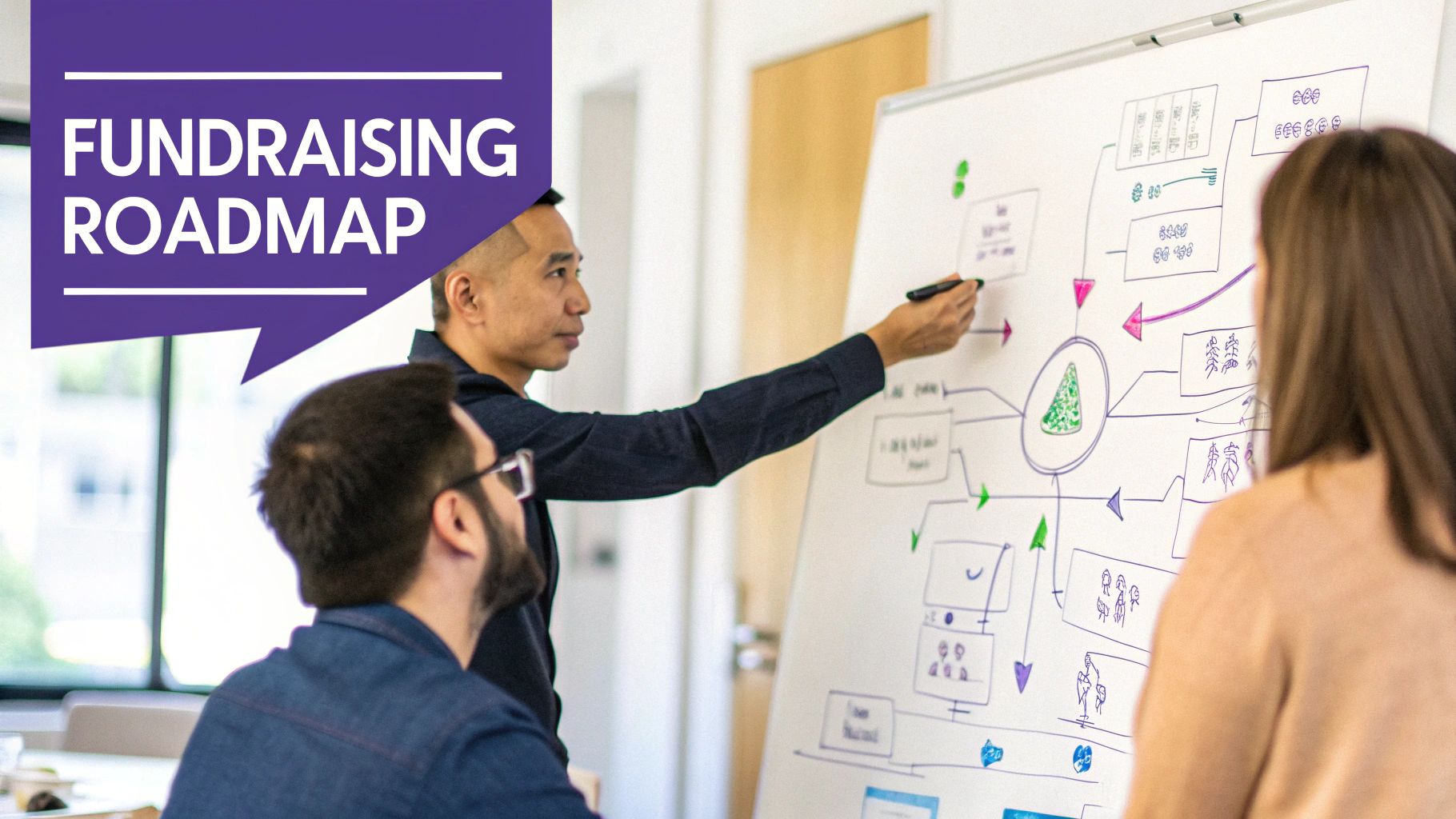
Get ready for a marathon. Raising a Series B is a demanding, multi-month slog that will test your company’s real-world traction and your own focus as a founder. This isn't like your earlier rounds. The game has shifted from selling a dream to presenting a cold, hard, data-driven case for why you’re on the path to market dominance.
The whole journey usually kicks off 3-6 months before you actually need the cash in the bank. It all starts with intense internal prep work. You'll be building out a comprehensive data room, stress-testing your financial models, and creating a pitch deck that tells a powerful story backed by metrics that can't be argued with. This isn't just a simple update to your Series A deck; it's a completely new story focused on predictable revenue and a well-oiled operational machine.
Assembling Your Pitch and Identifying Investors
Your Series B pitch deck has one job: prove your business is ready to scale, fast. The narrative has to revolve around your proven business model. You’ll be highlighting things like your LTV to CAC ratio, net revenue retention, and a crystal-clear strategy for grabbing a much bigger piece of the market. The entire document needs to shout 'growth potential,' not 'early-stage promise.'
With your story and materials locked in, the hunt for the right investors begins. This is about so much more than just finding firms with money. You need partners who know your industry inside and out and who have a proven history of helping companies like yours get to the next level. Start researching VCs who have led B rounds for similar businesses and try to build connections before you even need them.
Securing a strong lead investor is arguably the most critical step in the entire process. A respected lead not only provides a significant portion of the capital but also validates your company, making it much easier to attract other follow-on investors to fill out the round.
Mastering the Process from Pitch to Close
Once you have your target list, the fundraising machine kicks into high gear. Expect your calendar to be filled with dozens of meetings, deep-dive diligence sessions, and eventually, term sheet negotiations. It’s a full-time job that can easily pull you away from actually running your company, which is why having a structured plan is so important. A great way to prepare is by understanding the entire venture capital funding process from the investor's side of the table.
After you land that crucial lead investor and get a signed term sheet, you hit the final stretch: due diligence and closing. This is when the lawyers take over, meticulously verifying every claim you’ve made, from your financial statements to your customer contracts. Keeping the momentum going at this stage is the key to a fast, successful close, giving you the fuel you need to execute on your big growth plans.
Current Trends Shaping Series B Investments
The ground is always shifting in venture capital, and what gets a Series B deal done today is a world away from the playbook of just a few years ago. You’ve got big-picture economic forces, massive tech leaps, and changing investor tastes all stirring the pot. If you're a founder trying to raise growth capital, you absolutely have to know which way these currents are flowing.
One of the biggest waves, of course, is artificial intelligence. This isn’t just hype; it's a fundamental force redirecting huge pools of capital. VCs are on the hunt for companies that aren’t just using AI, but are either building foundational models or applying it in truly new ways to crack open old industries. If you can show a real competitive moat built on AI, you'll get a lot of attention and a much better valuation. To go deeper on this, check out our guide on how AI is impacting the venture capital space.
The Rise of Deep Tech and Impact Investing
It’s not all about software anymore, either. There's a growing hunger among investors for startups solving really hard, real-world problems. This has fueled a surge of funding into sectors that used to be seen as too risky, too slow, or needing way too much cash upfront.
We’re seeing this play out in a few key areas:
- Deep Tech: Think quantum computing, advanced materials, or even fusion energy. These companies are landing massive rounds because investors are making long-term bets on tech that could literally create new markets from scratch.
- Climate Solutions: Startups working on renewables, carbon capture, and sustainable agriculture are incredibly hot right now. The pressure to solve climate change is creating both a moral and a massive economic opportunity, and investors see that.
- Biotechnology: The potential for huge breakthroughs in drug discovery, personalized medicine, and other life sciences keeps the investment flowing. The impact—and the potential returns—are just too big to ignore.
This shift shows that investors are looking beyond the next app and toward businesses with missions that could genuinely change the world.
You want proof? In August 2025, the two biggest venture deals on the entire planet were both Series B rounds for deep tech companies. Commonwealth Fusion pulled in a staggering $863 million, and quantum computing startup Quantinuum raised $593.8 million. That’s a massive signal from the market about where the big money is heading. You can find more data on these shifting venture capital priorities on Crunchbase News.
Navigating a Cautious Capital Environment
While there's a ton of excitement in specific sectors, the overall mood is more cautious. Higher interest rates and general economic jitters mean that money isn't as free-flowing as it was during the boom times.
For founders, this changes the game. Investors are now obsessed with capital efficiency and a believable path to making actual money. The "growth at all costs" mantra is dead. Today, you have to prove you can grow and that you have a sustainable business model with solid unit economics. Series B is still about hitting the gas pedal, but now you have to do it smartly and with real financial discipline.
Life After Funding: Putting That Capital to Work
So, you’ve closed your Series B round. Champagne's been popped, backs have been patted. But that feeling of relief? It’s fleeting. Closing this round isn’t crossing the finish line; it’s the starting gun for an all-out sprint. This new capital comes with a new set of investors, a revamped board, and expectations that are through the roof.
The "what now?" phase is all about execution. You have to take that infusion of cash and turn it into real, defensible market leadership. It’s a period defined by strategic action, where every dollar is a tool meant to build a competitive moat around your business. For founders navigating this critical stage, it’s time to dig into proven strategies to scale your company to multimillion-dollar status and show your investors you can make their money work.
Where Does the Money Actually Go?
The overarching goal is simple: use the money to make your company an indispensable force in your market. This isn't just about getting more customers anymore. It's about building a sustainable growth engine that can run for the long haul.
Typically, smart companies pour their Series B capital into three core buckets:
- Aggressive Market Expansion: This is about stepping on the gas. You'll be scaling up your sales and marketing teams, pushing into new countries, or even going after entirely new types of customers you couldn't afford to target before.
- Deepening the Product Moat: The money goes right back into R&D. You’re building out features and capabilities that your competitors will find almost impossible to copy, making your product stickier and more essential to your users.
- Building a World-Class Team: This isn't just about filling empty chairs. You're now hunting for seasoned leaders—think VPs of Sales, Marketing, and Product—who have been through this scaling chaos before and know the playbook by heart.
So many founders make the mistake of seeing Series B capital as a safety net. It’s not. It’s high-octane fuel for a growth machine you’ve already designed. Every single dollar should have a job, tied directly to generating predictable revenue and making the entire operation run smoother.
A New Chapter of Accountability
The pressure to grow doesn't just increase after Series B; it transforms. Data pulled from one of the largest startup databases reveals that over 5,800 companies have historically raised a Series B round. Once you join this club, the conversations change. Investors, especially in a cautious market, want to see a clear, believable path to profitability or, at the very least, massive future revenue.
You can get a better sense of this landscape by checking out the journeys of other Series B startups on GrowthList. This intense accountability is what separates the companies that truly scale from those that just manage to stay alive.
Got Questions About Series B? We've Got Answers.
Stepping into a Series B round can feel like moving into uncharted territory. You've conquered the startup phase, but now the stakes are higher. Let's clear up some of the most common questions founders have at this critical stage.
How Long Does a Series B Round Really Take?
Plan for a marathon, not a sprint. A typical Series B fundraise takes anywhere from 3 to 6 months from start to finish. It’s a multi-stage process that you can't rush.
Think of it in three main phases:
- The Prep (1-2 months): This is where you get your house in order. You'll be building your data room, refining your pitch deck, and making sure your growth story is backed by solid numbers.
- The Pitch (1-3 months): Now you're actively meeting with investors, taking calls, and telling your story over and over. This phase can stretch depending on market appetite and how well your story resonates.
- The Close (1-2 months): Once you have a term sheet, the real work begins. This is the due diligence and legal phase, where investors scrutinize every detail before the money finally hits your bank account.
Of course, this timeline can shift. A hot company in a booming market might close faster, while a tougher economic climate could slow things down.
What’s a Realistic Valuation for a Series B Company?
There's no magic number here, but post-money valuations for a Series B typically land somewhere in the $50 million to $200+ million range. Valuations are less about guesswork and more about what your performance justifies.
Factors like your industry, revenue growth, and market position play a huge role. A fast-growing AI company, for example, will naturally command a higher valuation than a company in a less trendy sector. Don't get fixated on the eye-popping numbers you see in the headlines; focus on building a case for your valuation with undeniable metrics.
What Are the Biggest Mistakes Founders Make?
Many founders stumble on their way to a Series B. One of the most common mistakes is going out to raise too early, before the metrics are strong enough to tell a convincing story of scalable growth. Another classic pitfall is not having a crystal-clear plan for the money. Investors want to see exactly how their capital will be deployed to create a significant return.
But the single most dangerous mistake? Letting fundraising consume you. If you take your eye off the ball and let your core metrics slip while you're out pitching, it sends a massive red flag to investors. Nothing kills a deal faster than a sudden dip in performance.
Finally, don't waste your time talking to the wrong people. Research and target VCs who have a track record of investing in your industry and at your stage. A focused approach is always better than a shotgun blast.
Are you an agency looking to connect with freshly funded startups at the perfect moment? FundedIQ delivers hand-curated lists of companies that have just closed their funding rounds, complete with verified decision-maker contacts. Stop guessing and start engaging with high-intent prospects today. Learn more at https://fundediq.co.



